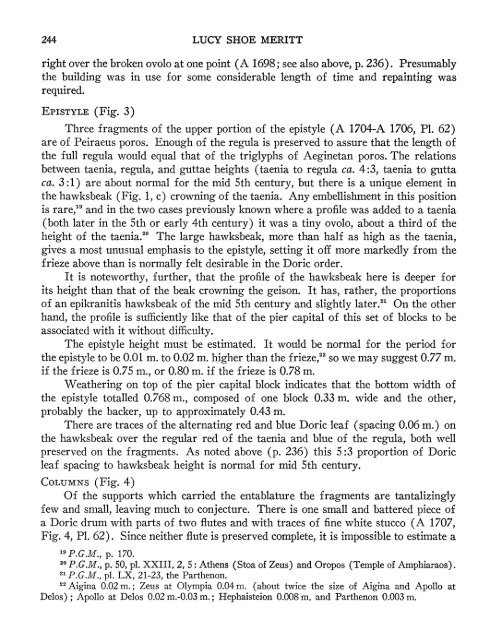the stoa poikile - The American School of Classical Studies at Athens
the stoa poikile - The American School of Classical Studies at Athens
the stoa poikile - The American School of Classical Studies at Athens
You also want an ePaper? Increase the reach of your titles
YUMPU automatically turns print PDFs into web optimized ePapers that Google loves.
244 LUCY SHOE MERITT<br />
right over <strong>the</strong> broken ovolo <strong>at</strong> one point (A 1698; see also above, p. 236). Presumably<br />
<strong>the</strong> building was in use for some considerable length <strong>of</strong> time and repainting was<br />
required.<br />
EPISTYLE (Fig. 3)<br />
Three fragments <strong>of</strong> <strong>the</strong> upper portion <strong>of</strong> <strong>the</strong> epistyle (A 1704-A 1706, P1. 62)<br />
are <strong>of</strong> Peiraeus poros. Enough <strong>of</strong> <strong>the</strong> regula is preserved to assure th<strong>at</strong> <strong>the</strong> length <strong>of</strong><br />
<strong>the</strong> full regula would equal th<strong>at</strong> <strong>of</strong> <strong>the</strong> triglyphs <strong>of</strong> Aeginetan poros. <strong>The</strong> rel<strong>at</strong>ions<br />
between taenia, regula, and guttae heights (taenia to regula ca. 4:3, taenia to gutta<br />
ca. 3:1) are about normal for <strong>the</strong> mid 5th century, but <strong>the</strong>re is a unique element in<br />
<strong>the</strong> hawksbeak (Fig. 1, c) crowning <strong>of</strong> <strong>the</strong> taenia. Any embellishment in this position<br />
is rare,19 and in <strong>the</strong> two cases previously known where a pr<strong>of</strong>ile was added to a taenia<br />
(both l<strong>at</strong>er in <strong>the</strong> 5th or early 4th century) it was a tiny ovolo, about a third <strong>of</strong> <strong>the</strong><br />
height <strong>of</strong> <strong>the</strong> taenia.2" <strong>The</strong> large hawksbeak, more than half as high as <strong>the</strong> taenia,<br />
gives a most unusual emphasis to <strong>the</strong> epistyle, setting it <strong>of</strong>f more markedly from <strong>the</strong><br />
frieze above than is normally felt desirable in <strong>the</strong> Doric order.<br />
It is noteworthy, fur<strong>the</strong>r, th<strong>at</strong> <strong>the</strong> pr<strong>of</strong>ile <strong>of</strong> <strong>the</strong> hawksbeak here is deeper for<br />
its height than th<strong>at</strong> <strong>of</strong> <strong>the</strong> beak crowning <strong>the</strong> geison. It has, ra<strong>the</strong>r, <strong>the</strong> proportions<br />
<strong>of</strong> an epikranitis hawksbeak <strong>of</strong> <strong>the</strong> mid 5th century and slightly l<strong>at</strong>er.2" On <strong>the</strong> o<strong>the</strong>r<br />
hand, <strong>the</strong> pr<strong>of</strong>ile is sufficiently like th<strong>at</strong> <strong>of</strong> <strong>the</strong> pier capital <strong>of</strong> this set <strong>of</strong> blocks to be<br />
associ<strong>at</strong>ed with it without difficulty.<br />
<strong>The</strong> epistyle height must be estim<strong>at</strong>ed. It would be normal for <strong>the</strong> period for<br />
<strong>the</strong> epistyle to be 0.01 m. to 0.02 m. higher than <strong>the</strong> frieze,22 so we may suggest 0.77 m.<br />
if <strong>the</strong> frieze is 0.75 m., or 0.80 m. if <strong>the</strong> frieze is 0.78 m.<br />
Wea<strong>the</strong>ring on top <strong>of</strong> <strong>the</strong> pier capital block indic<strong>at</strong>es th<strong>at</strong> <strong>the</strong> bottom width <strong>of</strong><br />
<strong>the</strong> epistyle totalled 0.768 m., composed <strong>of</strong> one block 0.33 m. wide and <strong>the</strong> o<strong>the</strong>r,<br />
probably <strong>the</strong> backer, up to approxim<strong>at</strong>ely 0.43 m.<br />
<strong>The</strong>re are traces <strong>of</strong> <strong>the</strong> altern<strong>at</strong>ing red and blue Doric leaf (spacing 0.06 m.) on<br />
<strong>the</strong> hawksbeak over <strong>the</strong> regular red <strong>of</strong> <strong>the</strong> taenia and blue <strong>of</strong> <strong>the</strong> regula, both well<br />
preserved on <strong>the</strong> fragments. As noted above (p. 236) this 5:3 proportion <strong>of</strong> Doric<br />
leaf spacing to hawksbeak height is normal for mid 5th century.<br />
COLUMNS (Fig. 4)<br />
Of <strong>the</strong> supports which carried <strong>the</strong> entabl<strong>at</strong>ure <strong>the</strong> fragments are tantalizingly<br />
few and small, leaving much to conjecture. <strong>The</strong>re is one small and b<strong>at</strong>tered piece <strong>of</strong><br />
a Doric drum with parts <strong>of</strong> two flutes and with traces <strong>of</strong> fine white stucco (A 1707,<br />
Fig. 4, P1. 62). Since nei<strong>the</strong>r flute is preserved complete, it is impossible to estim<strong>at</strong>e a<br />
19P.G.M., p. 170.<br />
20 P.G.M., p. 50, pl. XXIII, 2, 5: A<strong>the</strong>ns (Stoa <strong>of</strong> Zeus) and Oropos (Temple <strong>of</strong> Amphiaraos).<br />
21 P.G.M., pl. LX, 21-23, <strong>the</strong> Par<strong>the</strong>non.<br />
22Aigina 0.02 m.; Zeus <strong>at</strong> Olympia 0.04 m. (about twice <strong>the</strong> size <strong>of</strong> Aigina and Apollo <strong>at</strong><br />
Delos); Apollo <strong>at</strong> Delos 0.02 m.-0.03 m.; Hephaisteion 0.008 m. and Par<strong>the</strong>non 0.003 m.

















